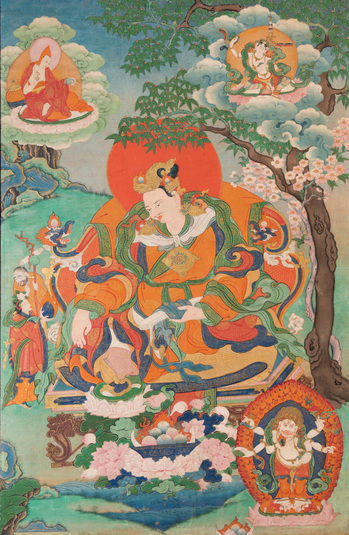
Item: King - Konchog Bang
| Origin Location | Tibet |
|---|---|
| Date Range | 1700 - 1799 |
| Lineages | Gelug and Buddhist |
| Material | Ground Mineral Pigment on Cotton |
| Collection | Anna Maria Rossi & Fabio Rossi |
Classification: Person
Appearance: King
Gender: Male
Gyalpo Konchog Bang is regarded, according to the Kadam Legbam text, as a pre-incarnation of Dromton Gyalwa'i Jungne (1004? - 1064 [TBRC P2557]). The Kadam Legbam itself was put into its final form by Chim Namkha Drag in the late 13th century. It is basically a series of stories said to be the episodes and narratives of the previous lives of Dromton as spoken and taught by Jowo Atisha.
Konchog Bang is the Tibetan name for an Indian king that is believed to have lived during the 1st millennium. All that we know of this king is what is recorded in the Kadam Legbam. The composition of the painting gives up little information. The three secondary figures have name inscriptions. The figure in the top right corner is Guhya Jnana. At the top left corner is Vimala Guru. At the bottom right is Chintamani Nata Mahakala. These paintings were however copied, duplicated and made as textiles products and became an iconic set of images to represent the incarnation lineage of the Dalai Lamas up to the present time. Most Western museums have at least one painting or textile from this set of works.

Konchog Bang is in the appearance of a king with a slightly furrowed brow, mustache, thickly layered colourful clothing and elaborate jewelry. The proper right hand is extended across the knee while the left holds a folio book in the lap. The head is surrounded bu a large red nimbus as the king sits on an elaborate throne with the proper right leg extended and resting on a flower blossom. Two attendant figures stand to the side.
At the top left is Vimala Guru as a monastic figure wearing robes, a pandita hat, and holding a vajra scepter and bell. At the top right is a figure of a woman, Guhya Jnana, white in colour, in the appearance of a peaceful deity, holding a double-sided drum (damaru) upraised in the right hand and a skullcup in the left. She cradles a katvanga staff in the bend of the elbow. Atop a moon disc and pink flower blossom, she sits with the proper left leg pendant. In some literature she is referred to as Daki Wangmo, or Daki Wangdu.
At the bottom right corner is the wealth deity, in wrathful appearance, Sita Chintamani Shadbhuja Mahakala, white, with six arms, holding a jewel, wealth vase carried in a skullcup, curved knife, double-sided drum, trident, and a vajra hook. Surrounded by orange and red flames, Shadbhuja stands with the legs together.
In the 17th century the Dalai Lamas also claimed to be the re-incarnation of Dromton thus linking themselves to Konchog Bang of India and all of the stories contained in the Kadam Legbam starting with Avalokiteshvara. This composition of Konchog Bang is the 2nd composition from a wood block print thirteen painting set depicting the previous incarnations of the 7th Dalai Lama, Kalzang Gyatso (1708-1757 [TBRC P179])
On the reverse of the painting is the Ye Dharma Formula written in Tibetan decorative letters but in the Sanskrit language: Om ye dharma hetu prabhava hetum tesham tathagato hyavadat tesham cha yo nirodha evam vadi maha shramana svaha.
Translation: "All phenomena arise from causes; Those causes have been taught by the Tathagata, And their cessation too has been proclaimed by the Great Shramana." (Rigpa Shedra translation).
Following the verse above there are an additional four lines of praise to Konchog Bang.
དྲི་མེད་བླ་མ་གསང་བ་ཡེ་ཤེས་ཀྱི།
ཐུགས་རྗེའི་ཟླ་ཟེར་གྱིས་བསྲིངས་ས་མོས་ཚལ།
རབ་བཞད་ཨོ་རྒྱན་ཡུལ་བགྲོད་མི་ཡི་བདག།
ལྷ་གཅིག་དཀོན་མཆོག་འབངས་ལ་གསོལ་བ་འདེབས།
"By the compassionate moon rays of Vimala Guru and Guhya Jnana, Nurturing the lily garden, Ripening the beings of the land of Uddiyana; To the One Lord Konchog Bang I pray!"
Each of the figures on the front have on the reverse of the painting the three syllables representing body, speech and mind, om, ah, hum, written at the locations of the forehead, throat and heart.
Jeff Watt 2-2017
Front of Painting
English Translation of Inscription: Vimala Guru, Guhya Jnana, Nata Chintamani.
Reverse of Painting
Wylie Transliteration of Inscription: "All phenomena arise from causes; Those causes have been taught by the Tathagata, And their cessation too has been proclaimed by the Great Shramana." (Rigpa Shedra translation).
"By the compassionate moon rays of Vimala Guru and Guhya Jnana, Nurturing the lily garden, Ripening the beings of the land of Uddiyana; To the One Lord Konchog Bang I pray!"
Special Features: (Cursive script (Umay), includes "Om Ah Hum" inscription)
Collection: Kapoor Galleries
Collection: Christies New York, March, 2023 (Painting)
Collection of Anna Maria Rossi & Fabio Rossi
King: Konchog Bang (India)

